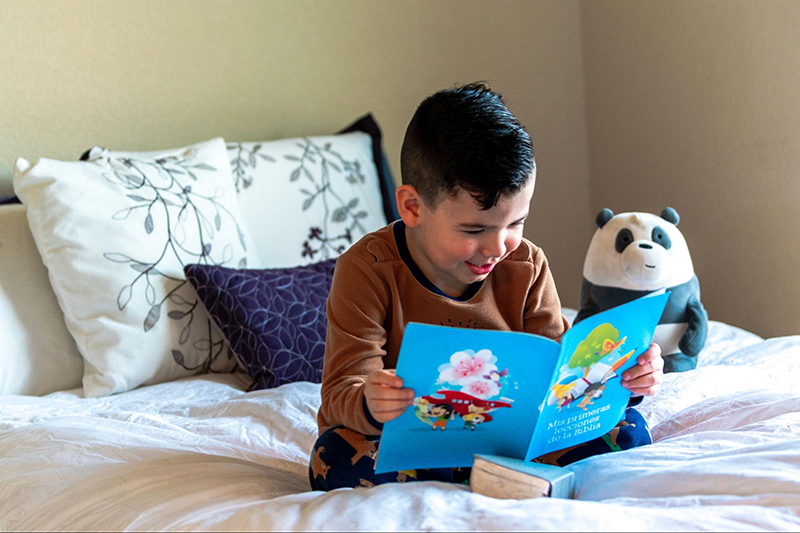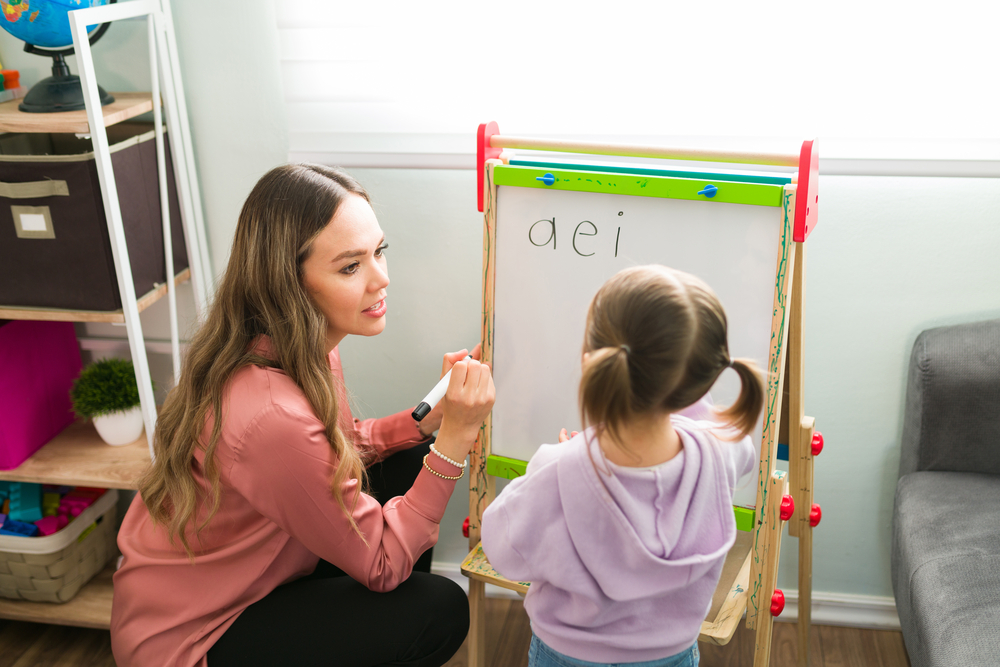Now that your young reader is no longer stopping to decode every word, it’s time to ensure they understand what they’re reading. Reading comprehension strategies, such as making connections, can help.
To help your child practice making connections while they’re reading, our experts share more about what this strategy entails. Then, we’ll look at the different types of connections your child can make while reading and share three reading activities you can try to build this skill.
Table Of Contents
- What Are Reading Strategies?
- What Is The Making Connections Strategy?
- 3 Tips For Practicing Making Connections
- 3 Activities To Help Your Child Make Connections
What Are Reading Strategies?

Sophisticated readers use a variety of strategies to help them make sense of what they’re reading.
Some reading strategies help kids learn to decode unknown words so they don’t get stuck when they come across one they aren’t sure how to read. Others work on reading comprehension.
In school, your child will learn many different comprehension strategies to become sophisticated readers, including:
- Asking questions
- Visualizing
- Activating prior knowledge
- Making connections
What Is The Making Connections Strategy?

Now that you know more about various reading strategies, let’s look at the making connections strategy.
This is when kids use their knowledge and experiences to connect with what they’re reading. Being able to connect to the text in a variety of ways can help them better understand and remember the story.
Since this strategy requires higher-level thinking skills, it’s not something your early readers will likely be practicing. However, if you have a younger child, you can begin introducing this concept little by little.
There are three main types of connections readers can make: text-to-self, text-to-text, and text-to-world. Let’s take a deeper look at each of these.
Text-To-Self Connections
A text-to-self connection is when a reader connects something they’re reading to their own life or experiences. For example, if your child is reading a book about moving and they’ve recently moved themselves, they’ll be able to relate to the characters on a more personal level.
You can help your child identify text-to-self connections by asking questions like:
- What does this remind you of?
- Have you ever felt this way before?
- How would you have reacted if this happened to you?
Since this strategy focuses a lot on feelings, ensure your child can express themselves well before practicing it.
If you need extra help with this social-emotional instruction, check out the HOMER Explore Feelings Kit. Its hands-on activities and play will help you teach your child about feelings and emotions — all while they’re having fun!.
Text-To-Text Connections
Sometimes, your child reads something in one book that makes them think of something they read in a different book. When this happens, they’re experiencing a text-to-text connection.
You can help your child identify text-to-text connections by asking questions like:
- How is this similar to another book we’ve read?
- What are the differences between this book and the last one we read?
- Does this book remind you of any others you’ve read lately?
- How is a character in this book similar to a character in another book? How are they different?
Text-To-World Connections
The text-to-world connection is often the hardest one for children to master. This strategy occurs when a reader connects something in a book to the real world around them.
You can help your child identify text-to-world connections by asking questions like:
- How would our lives be different if we lived where the characters live (on a farm, in the city, etc.)?
- How is the school in this story different from your school? How is it the same?
- How would this story be different if it happened today instead of in the past?
3 Tips For Practicing Making Connections
Now that you know all about the making connections strategy, let’s look at three ways you can help your child practice this critical reading skill.
1) Focus On One Type Of Connection At A Time
When introducing the concept of making connections, it’s best to focus on just one type at a time. Otherwise, your child will likely become overwhelmed and confused by trying to keep them all straight.
Since many readers innately make connections between themselves and what they’re reading, the text-to-self strategy is often the best place to start. Once your child has a good understanding of that connection, you can introduce the others.
2) Intentionally Select Reading Material

While your child can use the making connections strategy with any text, some books support this strategy more than others.
For example, if you’re practicing text-to-self connections, you’ll want to look for books with personal themes or situations that your child can relate to. Stories that feature school, family, friends, or emotions are good.
Here are a few of the best books for this strategy:
- Giraffes Can’t Dance by Giles Andreae
- Goodbye Old House by Margaret Wild
- The Pigeon and the Peacock by Jennifer L. Trace
If you want to focus on text-to-text connections, try looking for books in a series or by the same author. This way, your child can quickly see how the stories are similar and different from each other.
Here are a few fun authors to try:
- Leo Lionni
- Kevin Henkes
- Andrea Beaty
And, finally, if you’re looking for books to support text-to-world connections, try to find ones with settings or events that your child can easily connect to their own life and experiences.
Give these books a try:
- The Great Kapok Tree by Lynne Cherry
- Rainbow Weaver by Linda Elovitz Marshall
- Skin Like Mine by LaTashia M. Perry
3) Model The Strategy
The best way to help your child learn any new skill is to model it yourself. As you’re reading together, be sure to point out when and how you make connections.
Modeling helps them see how the strategy works and gives them a chance to practice. So, if you’re reading a book about a character going to school for the first time and you remember your first day, take time to talk about it.
You can say, “I remember my first day of school, too. I was so excited and scared at the same time!”
Then, you can invite your child to do the same. For example, say, “Do you remember your first day of school? How did it make you feel?”
3 Activities To Help Your Child Make Connections
1) Drawing Connections

If your child enjoys drawing, they’ll have fun with this activity!
What You’ll Need:
- Paper
- Drawing supplies (crayons, colored pencils, etc.)
- A book to read aloud that has events you think your child can connect with
What To Do:
Before reading aloud, give your child a piece of paper and some drawing materials. Tell them you have an important job for them.
Ask them to carefully listen to the story, and when they hear something that makes them think of something from their life, draw a picture. So, if you’re reading a book about visiting a zoo, they might think of when they went to the zoo and draw a picture of an animal there.
Once you’ve finished the story, ask your child to share what they drew. Let them explain what part of the story reminded them of what they drew and what is happening in their picture.
2) Fairy Tale Connections
To help your child practice all three types of connections, read a few fairy tales together and start asking some fun questions!
What You’ll Need:
- A book with familiar fairy tales
What To Do:
Read two or three fairy tales together. Cinderella, Goldilocks, and Snow White are fun ones to start with, but feel free to use any of your child’s favorites.
Once you’ve read a couple of tales together, ask your child about them. Here are a few questions to get you started:
- Can you think of a time when you felt like Cinderella?
- Goldilocks liked the bed that wasn’t too hard or too soft. What type of mattress do you like?
- Was the movie Cinderella like the book we read? What was the same, and what was different?
- How is Cinderella like Snow White?
- What do you think would happen if Goldilocks met Cinderella?
There are no right or wrong answers to these open-ended questions, so they’re the perfect way to get your child thinking and connecting.
3) Feeling Like A Character
There are often clues in the text that tell us how characters feel. You can use those clues to make connections.
What You’ll Need:
- A book to share with your child
- The magnets from the HOMER Explore Feelings Kit
What To Do:
Set the magnets nearby so your child can easily reach them while listening to you read. Before you begin, ask them to listen carefully for clues explaining how a character in the book might be feeling.
When they hear one, ask them to look for a magnet that expresses that feeling and hold it up. If you see your child holding a magnet, stop reading for a moment. Have them share what made them think about that emotion.
Next, ask them to share a time when they felt the same way. To mix things up, you can also ask if they can think of another character who shares this same feeling. Finally, ask your child to brainstorm different situations that might cause others to feel this way.
With a few simple questions, you’ll help your child learn more about expressing their emotions as they connect with the text.
Improve Comprehension By Making Connections

By connecting to a text in different ways, your child can better understand what they are reading and relate it to their own life. Use the above activities to help your child practice the making connections strategy.
Then, check out the HOMER Learn & Grow app for even more fun reading activities. It’s full of engaging games designed to help your child become a better reader.
No matter where your child is on their learning journey, with the right tools and support from you, they’ll be making connections in no time!











